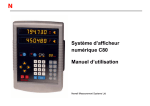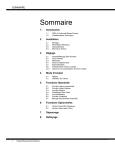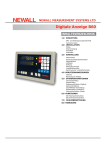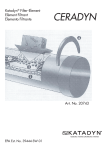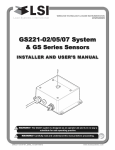Download INSTALLATION/USER MANUAL - Newall Electronics Inc.
Transcript
Newall Measurement Systems
INSTALLATION/USER
MANUAL
Contents
Contents
1.0 Introduction
1.1
1.2
EMC and Low Voltage Compliance
Technical Specifications
2.0 Installation
2.1
2.2
2.3
2.4
Mounting
Power Supply
Connections
Switching On
3.0 Set-Up
3.1
3.2
3.3
3.4
3.5
3.6
3.7
Sleep/Datahold
Axis Resolution
Display Resolution
Direction
Radius / Diameter
Linear Error Compensation
Head Fail Detection
4.0 User Instructions
4.1
4.2
Options
Using the Keypad
5.0 Standard Functions
5.1
5.2
5.3
5.4
5.5
5.6
5.7
Using Incremental
Using Absolute
Reference
Data Pre-set
Inch/Millimetre
Centrefind
Datahold (sleep)
6.0 Optional Functions
6.1
6.2
Topaz Digital Mill Version
Topaz Digital Lathe Version
7.0 Troubleshooting
8.0 Cleaning
1
Newall Measurement Systems
Introduction
1.0 Introduction
1.1 EMC AND LOW VOLTAGE COMPLIANCE
The Topaz Digital Readout conforms to the relevant European standards for electromagnetic compatibility and
low voltage directive as detailed below.
BS EN 50081-2:
Electromagnetic compatibility.
Generic Emission Standard - Industrial Environment
BS EN 50082-2:
Electromagnetic compatibility.
Generic Immunity Standard - Industrial Environment.
BS EN 61010-1:
Safety requirements for electrical equipment for
measurement, control and laboratory use.
1.2 TECHNICAL SPECIFICATIONS
Dimension:
Height:
Width:
Depth:
Weight:
140mm (5.5in)
240mm (9.5in)
80mm (3.2in)
2.5kg (5.5lbs)
Operating Voltage:
115 or 230V (switch selection)
Supply Voltage Fluctuation:
Not to exceed +/-15% of the operating voltage
Supply Frequency:
50 to 60 Hz
Maximum Power Consumption:
18VA
Operating Temperature:
0 to 45°C
Storage Temperature:
-20 to 70°C
Inputs
Connectors:
Input Signal Specification:
9 Way “D” - Type with the pinout arrangement as shown in Section 2.3.1
A,/A.B,/B Quadrature Inputs with RS422 compatible line receivers
Differential or Single Ended Option
Input circuit diagram shown in Section 2.3.2
Reference Input:
R, /R Reference input with RS422 compatible line receiver
Differential or Single Ended option
Input circuit diagram shown in Section 2.3.2
Power Supply:
5V DC with a maximum output of 250mA per axis
Resolution Options:
0.01mm / 0.005mm / 0.002mm / 0.001mm / 0.0005mm / 0.0002mm / 0.0001mm
Environmental Conditions:
Indoor Use, IP20 (IEC 529)
Relative humidity
- maximum 80% for temperatures up to 31°C decreasing
linearly to 33% at 45°C
Transient overvoltage according to INSTALLATION CATEGORY II of IEC664
POLLUTION DEGREE 2 in accordance with IEC664
NOTE:
NEWALL MEASUREMENT SYSTEMS RESERVES THE RIGHT TO CHANGE
SPECIFICATIONS WITHOUT NOTICE.
Newall Measurement Systems
2
Installation
2.0 Installation
The symbol below appears on the equipment and refers to the safety aspects detailed below.
2.1 MOUNTING
Topaz Digital is supplied with a fixing kit consisting of a M10 stud, nut and washers. Figure 1.2b shows use
of this in conjunction with a mounting arm.
Be sure that the mounting arrangements are secure as the operator will need to apply pressure to the front
panel when using the keypad.
A single or double mounting arm bracket can be supplied as a optional extra.
An optional mounting assembly (Part no: 294-37740) is available which allows for tilt and rotation (See Figure
1.2a).
Select the location of the Topaz Digital with due regard to safety and ease of operation. Keep clear of
moving parts and coolant spray. Ensure that the natural ventilation around the cabinet is not restricted.
To ensure correct operation of the Topaz Digital, it is recommended that the unit’s case is grounded to the
machine upon which it is fitted. Use a wire or strap of a least 1.5mm2 (16 AWG) from the cabinet
equipotential terminal (See Figure 1.3) to a suitable point on the machine body. The wire should be as short
as possible. The machine must also be properly grounded to a good earth point.
2.2 POWER SUPPLY
BEFORE CONNECTING THE ELECTRICAL SUPPLY TO THE CABINET, CHECK THAT THE VOLTAGE
SELECTOR SWITCH IS CORRECTLY SET. Figure 1.3 shows the position of this switch.
The mains supply is connected through a detachable supply cord. The Topaz Digital is supplied with a cord
with a right-angle connector. If another supply cord is used, it must have fitted a IEC320, 10A, EARTHED
mains connector with a cord rated for at least 10A.
The PROTECTIVE EARTH CIRCUIT of the mains supply MUST BE CONNECTED to the protective earth
terminal of the cabinet through the supply cord.
The supply cord should be secured to the mounting arm or pillar with cable ties to ensure that it cannot drop
into a hazardous position, ie. the floor or coolant tray, when disconnected from the cabinet.
The supply cord must be routed away from moving parts, swarf, coolant or sources of heat.
If a mains plug is not already fitted to the supply cord or is of the wrong type, then a suitable EARTHED plug
should be used which complies with the relevant specifications for plugs and socket-outlets.
The mains supply fuse is a 20x5mm, type T0.5A, 250V. It is not to be replaced by the operator. If the fuse
blows it is a possible indication of some significant problem with the power source. Check the supply and
wiring carefully. If the fuse is replaced, the cabinet must first be disconnected from the supply by the removal
of the IEC socket from the inlet. Do not position the equipment so that it is difficult to operate the disconnect
device.
NOTE:
3
If the equipment is used in a manner not specified by the manufacturer, the protection
provided by the equipment may be impared and may invalidate any warranty given.
Newall Measurement Systems
Figure 1.1 & 1.2
CONCEALED KEY
FOR ENTERING
SET-UP ROUTINE
Figure 1.1 Front View (3 Axis Mill)
Mounting Arm
Mounting Arm
(b)
(a)
Figure 1.2 Mounting Arrangements
Newall Measurement Systems
4
Figure 1.3
Figure 1.3 Connection Diagram
5
Newall Measurement Systems
Installation
2.3 CONNECTIONS
Figure 1.3 shows the connection sockets at the back of the Topaz Digital. The Topaz Digital is designed for
use with single ended or differential quadrature output encoders. See section 2.3.1 for connectors details.
The encoders are connected to the Topaz Digital with 9-pin D Type connectors.
Switch off the Topaz Digital before connecting or disconnecting the encoders. To fit the connectors into the
appropriate socket on the back of the Topaz Digital, first align the connector and then push firmly in place
and secure with the locking bolts. To remove the connector, disengage the locking mechanism and pull the
connector clear.
The encoders and digital readouts are connected at a separated extra low voltage (SELV) level. Any
additional interconnections must also be at SELV level.
2.3.1
ENCODER CONNECTIONS
The axis connectors consist of 9 Way “D”-Type connectors with the following pin assignments for both single
ended and differential connections, this is dependent on the Topaz Digital model.
PIN NUMBER
1
2
3
4
5
6
7
8
9
SINGLE ENDED
DIFFERENTIAL
OV
Phase A+
Disconnect
Phase B+
Disconnect
OV
+ 5V
Index+
Disconnect
OV
Phase A+
Phase APhase B+
Phase BOV
+ 5V
Index+
Index-
2.3.2 INPUT TYPE
DIFFERENTIAL INPUT CONFIGURATION
Note:
SINGLE ENDED INPUT CONFIGURATION
When the encoder does not have a index marker pulse, the index+ pin should be
connected to OV (pins 1 or 6). If this is not possible then the signal failure defect
option must be turned off for that axis. See section 3.7
Newall Measurement Systems
6
Installation
Default Setting
Topaz Standard
Topaz Mill
Topaz Lathe
Off
Off
Off
Axis Resolution
0.001mm
0.001mm
0.001mm
Display Resolution
0.001mm
0.001mm
0.001mm
1
1
1
Rad
Rad
X=Dia Z=Rad
0
0
0
On
On
On
Sleep
Direction
Radius/Diameter
Linear Compensation
Signal Failure
Table 1 - Default Settings
SLEEP
ON
OFF
AXIS RESOLUTION
0.01mm / 0.005mm / 0.002mm / 0.001mm /
0.0005mm / 0.0002mm / 0.0001mm
DISPLAY RESOLUTION
0.01mm / 0.005mm / 0.002mm / 0.001mm /
0.0005mm / 0.0002mm / 0.0001mm
DIRECTION
0
1
READINGS
RADIUS
DIAMETER
LINEAR ERROR COMPENSATION
USER DEFINABLE
HEAD FAIL DETECTION
ON
OFF
Table 2 - Menu Options
7
Newall Measurement Systems
Installation/Set-Up
2.4 SWITCHING ON
The mains supply switch for the Topaz Digital is mounted on the back of the unit as shown Figure 1.3.
When you switch on the Topaz Digital the unit will automatically go through a brief self diagnostic routine.
During this routine, the name Digital will be shown then the software version number will be displayed and all
segments of the displays will be lit.
After this routine, the unit will display measurements and is ready for use.
CONVENTIONS USED IN THIS MANUAL
The direction of travel of an axis refers to the travel of the tool relative to the
workpiece. Keys on the keypad are signified in bold print,
such as [ ent ] for the enter key.
3.0 Set-Up
The Set-Up procedure allows you to to change the main default settings as shown in Table 1.
The Set-Up procedure can only be activated just after power is switched on to the unit. After switching on,
press the concealed key which is located under the "ne" of the newall logo on the keypad. The key must be
pressed before the end of the initial self diagnostic routine.
When you have entered the Set-Up routine, the letters ‘SET-UP’ appear in an axis display window.
The Set-Up procedure makes use of a menu system. The main menu consists of a list of options that can be
customised for your use. Press the [ abs/inc ] key to scroll through this list until you reach the option you
wish to change. To change the option when selected, press the [ Xo ], [ Yo ] or [ Zo ] key.
To exit the Set-Up routine press the concealed key ("ne" of newall).
The Set-Up menu structure is shown in Table 2.
3.1 SLEEP/DATAHOLD
In the Set-Up routine, press the [ abs/inc ] key until "SLP ON" is displayed. Press [ Yo ] and the choice of
"SLP OFF" appears. You can toggle between "SLP ON" or "SLP OFF" by pressing the [ Yo ] key.
Select "SLP ON" if you want to be able to use the Datahold facility. Otherwise select "SLP OFF".
Newall Measurement Systems
8
Set-Up
3.2 AXIS RESOLUTION
This option allows you to select the resolution of the encoder for a given axis. The list below shows the axis
resolution settings, expressed in mm, that are available .
0.01mm / 0.005mm / 0.002mm / 0.001mm / 0.0005mm / 0.0002mm / 0.0001mm
In the Set-Up routine, press the [ abs/inc ] key until “AR” (Axis Resolution) is displayed. The display will
show the last selected resolution eg. “Ar 0.001”.
Press the [ Xo ] [ Yo ] or [ Zo ] key to change the resolutions.
When the unit is displaying the choices you wish to use, press [ abs/inc ] to continue to the next option.
3.3 DISPLAY RESOLUTION
This option allows you to select the Display Resolution, for a given axis, from the resolution settings availble.
The resolution settings are the same as the Axis Resolution settings, except that the highest resolution available is limited to the resolution that was selected for the Axis Resolution. This prevents selection of a Display
Resolution that is higher then the Axis Resolution.
In the Set-Up routine, press the [ abs/inc ] key until “DR” (Display Resolution) is displayed. The display will
show the last selected resolution eg. “dr 0.001”.
Press the [ Xo ] [ Yo ] or [ Zo ] key to change the resolutions.
When the unit is displaying the choices you wish to use, press [ abs/inc ] to continue to the next option.
Note:
Ensure Axis Resolutions are correctly selected, before selecting the desired Display
Resolution.
3.4 DIRECTION
The direction option allows you to change the direction of travel of each axis. For example, if after
installation the X axis is measuring positive from right to left, you can use this option to change the direction
of the X axis so it measures positive from left to right.
In the Set-Up routine, press the [ abs/inc ] until "DIR" (direction) is displayed.
Each axis display will show "0" or "1"
Pressing each axis key [ Xo ] [ Yo ] or [ Zo ] reverses the counting direction. When the unit is displaying the
choices you wish to use, press [ abs/inc ] to continue to next option.
9
Newall Measurement Systems
Set-Up
3.5 RADIUS/DIAMETER
This option allows you to select any axis to display measurements at a two times (x2) factor. This is used on
lathes and other turning applications to display part diameter rather than part radius.
In the Set-Up routine, press the [ abs/inc ] key until "R A D" or "DIA" is displayed.
Pressing each axis key [ Xo ], [ Yo ] or [ Zo ], switches between radius and diameter readings for that axis.
When the unit is displaying the choices you wish to use, press [ abs/inc ] to continue to the next option.
3.6 LINEAR ERROR COMPENSATION
This option allows you to apply a constant correction factor to all measurements displayed. This factor is
expressed in parts per million (PPM).
In the Set-Up routine, press the [ abs/inc ] key until “LC” (Linear Compensation) is displayed. The display
will show "LC 0" or the last correction factor entered.
To insert or change a correction factor, select the axis and enter the factor you wish to use.
For example, to apply a factor of 200PPM to the X axis, press the following keys: [ X ][ 2 ][ 0 ][ 0 ][ ent ] .
If the unit is displaying measurements less than the actual measurement, enter a positive factor to compensate. A factor of 200PPM means displays are measurement x 1.000200. When each axis is displaying the
correction factor you wish to use, press [ abs/inc ] to return to the first option.
3.6.1 CALCULATING LINEAR ERROR COMPENSATION
To establish a multiplication factor, check the measurements displayed by the axis against a known
distance. The multiplication factor should be established while in operational mode and NOT in the Set-Up
routine.
For example, you might use a known (standard) distance of 500mm, against which the axis displays
499.8mm. The correction factor you would then apply is:
(0.2mm/500mm) x 1,000,000 = 400PPM
If the axis displays 500.2mm over the same distance, the correction factor would be:
(-0.2mm/500mm) x 1,000,000 = -400PPM
WARNING. Once you have entered a multiplication factor for an axis, all measurements will be adjusted
accordingly. If you wish to disable this adjustment, you will have to enter a compensation factor of zero.
Newall Measurement Systems 10
Set-Up
3.7 HEAD FAIL DETECTION
Each axis can detect for the condition of a failed read head. This option allows you to enable or disable the
axis fail detect function for each axis.
In the Set-Up routine, press the [abs/inc] key until FAIL is displayed.
Pressing each axis [X0],[Y0],or [Z0], switches between FAIL ON and FAIL OFF for that axis. When
the unit is displaying the choices you wish to use, press [abs/inc] to continue to the next option.
Note: For the correct, operation of the head signal failure function the following note applies. The head
signal failure detection system works by monitoring the incoming signal for the illegal input
combination of A low, B low, and R (reference mark) high. If the head signal fails, or is
disconnected, then the illegal input combination is generated internally within the Topaz Digital read
out. The corresponding axis reading then displays SIG FAIL . If the read head, that is connected to
the Topaz Digital readout, can generate the input signal combination of A low, B low, and R high in
a normal state, then the axis fail detect function must be disabled.
During normal operation, with the head fail detection enabled, removal of a read head connector causes the
corresponding axis to display SIG FAIL . If the read head is reconnected then the axis display continues to
show SIG FAIL until the corresponding axis zero key [X0], [Y0],[Z0] or axis load key [X], [Y],[Z] is
pressed followed by [ent].
A
B
R
ILLEGAL CONDITION
Note:Please check encoder manual for index marker specification.
A
B
R
Status
L
L
H
SIG FAIL
0
1
H
OK
1
0
H
OK
X
X
L
OK
To leave the Set-Up routine press the concealed key, "ne" of newall.
11 Newall Measurement Systems
User Instructions
4.0
User Instructions
4.1 OPTIONS
Topaz Digital is available in three models, the Standard, Mill and Lathe. Figure 1.4
shows the layout of the various keypad configurations.
MODELS
2 Axes
3 Axes Additional Features
Topaz Digital Standard
✓
✓
Topaz Digital Mill
✓
✓
PCD “Bolt Hole Circle” mode
✓
Tool Off-Sets mode
Topaz Digital Lathe
4.2 USING THE KEYPAD
Figure 1.4 shows the layout of the keypad. The keys are used as follows:
KEY
PURPOSE
Xo
Yo
Zo
X
Y
Z
Set the current position for the axis to zero (reset)
Select axis to enter dimension (preset)
Switches between absolute and incremental readings
(LED indicates choice of mode)
abs
inc
ce
Clear entry values in preset mode
1
Centre find function
2
ent
Enter key to confirm data entry
ref
Find the reference position
in
mm
Switches between inch and millimetre display
(LED indicates choice of mode)
±
1
2
3
4
5
.
6
7
8
9
0
Set
Numeric keypad for data entry
For setting tool off-sets (Lathe model only)
Calls up the tool number to be used (Lathe model only)
For using the pitch circle diameter (PCD) function (Mill model only)
Newall Measurement Systems 12
User Instructions
2) 2 Axes Mill
2) 3 Axes Mill
2) 2 Axes Lathe
5) 2 Axes Standard
6) 3 Axes Standard
Figure 1.4 Keypad Layout
13
Newall Measurement Systems
Standard Functions
5.0
Standard Functions
5.1 USING INCREMENTAL
(a)
Purpose and Use
When the Topaz Digital is set to incremental mode, it
can be used to display each new position relative
to the last position. This is also known as point-to-point use.
On setting to incremental you can reset each axis by
pressing [ Xo ] [ Yo ] or [ Zo ].
70
30
40
50
As an alternative to resetting the axes, you can enter the coordinates relative to the current incremental
position.
Each time you switch to incremental mode, the Topaz display will show the position relative to the last reset
position while in the incremental mode.
(b)
Keystrokes
OPERATOR STEPS
KEYSTROKES
AXES DISPLAY
Set to incremental mode
[ abs/inc ]
Reset axes
[ Xo ]
[ Yo ]
[ Zo ]
X
Y
Z
Enter the coordinates of
a position, eg X100, Y50, Z25
[ X ][ 1 ][ 0 ][ 0 ][ ent ]
[ Y ][ 5 ][ 0 ][ ent ]
[ Z ][ 2 ][ 5 ][ ent ]
X100.00
Y 50.00
Z 25.00
0.00
0.00
0.00
5.2 USING ABSOLUTE
(a)
Purpose and Use
When the Topaz Digital is set to absolute mode it will
display the position relative to an established datum point.
30
100
140
(b)
190
Keystrokes
OPERATOR STEPS
KEYSTROKES
Set absolute mode
[ abs/inc ]
AXES DISPLAY
Newall Measurement Systems 14
Standard Functions
(c)
Establishing the Datum
When you reset the display in absolute mode, you are setting the current position of your machine as your
datum point. All absolute positions will be measured relative to this datum.
To set the datum, position the machine at the point you intend to establish the datum and then reset any or
all axes, while in the absolute mode.
Keystrokes
OPERATOR STEPS
KEYSTROKES
Set to absolute mode
[ abs/inc ]
AXES DISPLAY
Move machine to the
datum location
Reset axes
[ Xo ]
[ Yo ]
[ Zo ]
X 0.00
Y 0.00
Z 0.00
5.3 REFERENCE
Note: This function only works with encoders that provide an index marker output signal.
This feature allows for any given axes to be referenced to a datum position. The index marker pulse, from
the encoder, is used to generate a signal that informs the DRO that the reader head has reached its datum
position. Index pulses generally appear in one or two forms depending on the type of encoder connected.
These can either be periodic, say every 20mm, or single action. Generally, when a scale has a single action
index marker this is located at the centre of travel.
5.3.1
PERIODIC INDEX PULSES
Position the encoder such that it lies between the datum index marker and the next index marker position.
(Say, within ±15mm for a 20mm index period).
Hint: Mark the datum position on the machine bed to allow for this position to be located quickly.
Press the Ref Key [ref]
Select the axis to datum, [X], [Y], [Z]. The axis will be reset to zero.
Move the axis towards the datum index position. Once the index marker has been triggered the axis will
start to count. The axis position is now referenced to that datum position.
15 Newall Measurement Systems
Standard Functions
5.3.2
SINGLE END MARKER
Press the Ref Key [ref]
Select the axis to datum, [X], [Y], [Z]. The axis will be reset to zero.
Move the axis towards the datum index position. Once the index pulse has been triggered the axis will start
to count. The axis position is now referenced to that datum position.
Note: Refer to the encoder manual for specification information relating to its index mark
5.4 DATA PRE-SET
To pre-set an axis dimension the following steps are required.
Select axis to preset [X] [Y] [Z]
Enter value to load into axis (use numerical keypad), if value is to be negative select [ ± ]
Press [ent] to load entered value into the axis
Note:
Pressing [ce ], prior to pressing [ent] will cancel the operation and return the axis to the
original value.
Keystrokes
OPERATOR STEPS
KEYSTROKES
AXES DISPLAY
To enter a negative
dimension for X the axis
[ X ][ ± ][ 1 ][ 9 ][ . ][ 6][ ent ]
X -19.600
Dimensions can be entered in either absolute or incremental modes.
Newall Measurement Systems 16
Standard Functions
5.5 INCH/MILLIMETRE
To change between inch and millimetre readings, press [ in/mm ]. The displayed data will be converted
instantly. The LED beside the key reminds you which mode is being used.
When you switch on the Topaz Digital, it will display the same unit of measurement which was set prior to
power loss.
5.6 CENTRE FIND
Centre Find halves the dimension displayed for any or all axes selected. You can use Centre Find in either
absolute or incremental mode. The keystrokes are the same in either case.
In the following example, Centre Find is being used on the X axis to find the centre point of a workpiece that
is 100mm wide.
OPERATOR STEPS
KEYSTROKES
AXES DISPLAY
Locate to your first position
(one edge of your workpieceand zero the axis)
[ Xo ]
X
Locate to the second position
(the other edge of the workpiece)
Use Centre Find to locate the
centre point
0.00
X100.00
[ X ][ ½ ] or [ ½ ][ X ]
X 50.00
In either absolute mode or incremental mode, once you have used Centre Find you can locate to the centre
point by moving until the display is at zero.
Note: If you are in absolute mode, remember that using centre find will set the datum to the centre
point.
5.7 DATAHOLD (SLEEP)
Datahold allows you to disable the Topaz Digital but retain power to the measurement encoders and the
memory circuits. You can use datahold to prevent unauthorised or accidental use of the Topaz Digital whilst
unattended.
To select datahold, press the concealed key under the "ne" of the "newall" logo (See Figure 1.1).
While the Topaz Digital has been set to datahold, the keypad will not function and the displays will be blank.
If the machine axis is moved, "DISPLACD" (displaced) will appear in the display window. The Topaz Digital
will continue to record all transducer movement and will update the display once datahold is cancelled. If a
key is pressed, "TO U C H E D" (touched) will appear in the display to alert the operator that data entry has
been attempted.
Note: To awaken the unit from datahold, press the concealed key (“ne” of the newall logo).
17 Newall Measurement Systems
Optional Functions
6.0
Optional Functions
6.1 TOPAZ DIGITAL MILL VERSION
The Topaz Digital Mill version is available in two or three axes and offers Pitch Circle Diameter (PCD) in addition
to the Standard functions. PCD is also known as “Bolt Hole Circle”. The convention for angular position is that the
0 degree position is at 3 o’clock and positive angles are measured anti-clockwise.
6.1.1
2 AXIS MILL VERSION
(a) To access the PCD function press
(b) The two digit LED shows the letter “C ” for centre. Each of the axes display the last entered coordinates
for the circle centre
(c) Enter the required centre points for the new PCD. eg [ X ][ 2 ][ 2 ][ . ][ 5 ][ ent ], [ Y ][ 2 ][ 5 ][ . ][ 5 ][ ent ]
Press [ > ] to move to the next input.
(d) The two digit display now shows “D ” prompting the diameter input. The X axis shows the last entered
value for a circle diameter. The other axes are blank.
(e) Enter a new diameter eg. [ 2 ] [ 0 ] [ ent ] Press the [ > ] key to move to the next input.
(f)
The display now shows “N ”, prompting the number of holes to be input. The X axis shows the last
entered value for the number of holes.
(g) Enter the number of holes in the pattern followed by [ ent ], eg. [ 5 ] [ent]. Press [ > ] to advance to the next
input.
(h) The display now shows “A ” for angle of the first hole. The X axis display shows the last entered angle.
Enter a new angle in decimal degrees followed by [ ent ] eg. [1] [8] [ent]. Note: Until this point the [ < ]
key will allow the operator to move backwards through the previous inputs and make any amendments.
18°
0°
20
25.5
(i)
5 holes equally spaced
22.5
Newall Measurement Systems 18
Optional Functions
(j)
Pressing [ > ] key after the angle input will display the first hole position.
(k) [ < ] or [ > ] now scrolls through the various hole locations. Each hole number being identified in the
two digit display. The PCD feature functions as a “go to zero” command. The coordinates displayed
with each hole number indicate the distance needed to travel to reach the hole location. To position to
each hole location, move the axes until both of the displays read “0.000”.
(l)
Pressing the PCD icon
6.1.2
returns the display to the standard function.
3 AXES MILL VERSIONS
The 3 axes mill operates in a similar manner to the 2 axes version except that the PCD is plane selectable.
(a) On the 3 axes version when the PCD icon is pressed
the first input in the 2 digit display is the
plane “P”. The plane is identified by the horizontal LED segment adjacent to the corresponding axis.
(b) The [ abs/inc ] key scrolls between (x,y), (x,z) and (y,z) planes when pressed. When the desired plane
is displayed press [ > ] to move to the next input “C ” for centre position. All subsequent inputs are as
the two axis version.
6.2 TOPAZ DIGITAL LATHE VERSION
Note:
The conventional method of setting a lathe is to set the X axis as the cross travel and the Z
axis as the longitudinal.
6.2.1 TO SET THE OFFSETS
(a) Press
Set
to activate the tool set mode.
(b) Press [ > ]. The two digit display will show the first tool as “01”.
(c) To datum the X axis take a skim cut along the outside diameter. Move the tool away from the part but do
not move in the X axis. Measure the diameter and enter the diameter of the part in to the X display.
i.e.[ X ][ 2 ][ 5 ][ent]
(d) To datum the Z axis take facing cut and move the tool away from the part but do not move in the Z
axis. Enter zero in the Z display. i.e. [ Z ][ 0 ][ ent ]. The [Xo] and [Zo] keys are inactive in the tool set
mode.
(e) Press [ > ] to advance to the next tool. i.e. “02 will be displayed in the two digit display.
(f)
To set the remaining tools repeat (c) as above to datum the X axis. To datum the Z axis for each tool
touch the tool onto the face and enter [ Z ][ 0 ][ ent ].
(g) Press
Set
to exit the tool set mode.
19 Newall Measurement Systems
Optional Functions
6.2.2 TO USE THE TOOLS WITH OFFSETS
(a) Press
. The 2 digit display now shows “01”. Use the [ < ] and [ > ] keys to advance to the
tool which is to be used.
(b) Datum the displays in the normal way. Use the [ < ] and [ > ] keys when changing tools. The display
will show you true X and Z readings for the tool shown in the two digit display.
(c) Press
to exit tool use mode.
6.2.3 EDITING TOOL OFFSETS
Tool editing allows you to update a tool offset should the tool become worn, broken or need replacing.
(a) Before editing the offset it is first necessary to activate an unchanged tool in tool use mode. Press
and select the tool.
(b) To datum the X axis take a skim cut along the outside diameter. Move the tool away from the part but do
not move in the X axis. Measure the diameter and enter the diameter of the part into the X display.
e.g. [ X ][ 2 ][ 5 ][ent]
(c) To datum the Z axis, take a facing cut and move the tool away from the part but do not move in the Z
axis. Enter zero in the Z display. i.e. [ Z ][ 0 ][ ent ]. The [Xo] and [ Zo] keys are inactive in the tool set
mode.
(d) Press
(e) Press
(f)
to exit tool use mode.
Set
to activate the tool offset mode.
Use the [ < ][ > ] keys to scroll to the tool to be edited. As an alternative the tool number may be
entered directly. e.g. [ 1 ][ 1 ][ ent ].
(g) To establish the X axis offset take a skim cut along the outside diameter. Move the tool away from the
part but do not move in the X axis. Measure the diameter and enter the diameter of the part into the X
display. e.g. [ 2 ] [ 5 ] [ ent ]
(h) To establish the Z axis offset touch the end face with the tool and enter zero in the Z axis display.
e.g. [ 0 ][ ent ]. The [Xo] and [ Zo] keys are inactive in the tool set mode
(i)
Press
Set
to exit tool set mode.
Newall Measurement Systems 20
Troubleshooting/Cleaning
7.0
Troubleshooting
SYMPTOM
SOLUTIONS
1 Nothing happens when the
unit is switched on.
Check that the Topaz Digital is correctly connected to a working power
source.
Check the power lead is not damaged.
Check the selector switch on the Topaz Digital is set to accept the
correct power supply voltage.
Check the fuse. Note that if the fuse has blown, this suggests a fault
with the power source which must be corrected before the fuse is
replaced. (See Section 2.2)
2 When the unit is switched on
the displays are frozen.
This suggests that the mains supply voltage is to low.
Check that the power source is within the limits accepted by the Topaz.
(See Section 2.2)
3 The displays work, but reset
from time to time without the
keys being pressed.
This suggests either that the mains supply voltage is too low,
or that the power source has an intermittent fault.
Check the power source as above.
Check that all connections are sound.
4 The displays work, but give
erratic readings, the last digit
jitters or the measurements jump
to new figures unexpectedly.
This suggests that the there is a poor earth (ground) connection.
Both the Topaz Digital, and the machine on which it is installed, must
have proper earth (ground) connections. (See Section 2.1)
5 “SIG FAIL” appears in
the display.
This means that the unit is not receiving a proper signal from
the measurement encoder.
Check that the encoder connection is good.
Check that there is no damage to the connectors or to the encoder
lead. If only one axis is displaying this message, connect the
transducer from a working axis into the faulty axis. If the same
message appears, the fault is likely to be in the Topaz and you
should contact your local dealer. To clear the signal fail message select
that axis [X], [Y], [Z] and then press [ent] . If this signal fail message
remains, the fault has not been corrected.
6
The unit will not respond to keys.
Switch the Topaz Digital off and back on. Note that providing the
machine has not been moved in any direction you will
not lose your current position by switching off and on.
8.0 Cleaning
Disconnect the cabinet from the power supply before cleaning.
It is recommended that the cabinet be wiped over with a lint-free cloth with a non corrosive/abrasive cleaning fluid.
Do not use compressed air.
21 Newall Measurement Systems
Notes
Newall Measurement Systems 22
NEWALL MEASUREMENT SYSTEMS LTD
64 Percy Road . Leicester . LE2 8FN . England
Tel: (44) 0116 283 3899 . Fax: (44) 0116 283 5530
E-mail: [email protected]
NEWALL FRANCE SARL
63 Rue Victor Hugo . F-59200 . Tourcoing . France
Tél. 03 20 01 03 13 . Fax 03 20 26 13 41
E-mail: [email protected]
NEWALL ELECTRONICS INC
1778 Dividend Drive . Columbus . Ohio . 43228 . USA
Tel: (1) 614 - 771 0213 . Fax: (1) 614 - 771 0219
E-mail: [email protected]
Website: www.newall.co.uk
Code: 023- 60230-UK Issue Date: March 2000

























